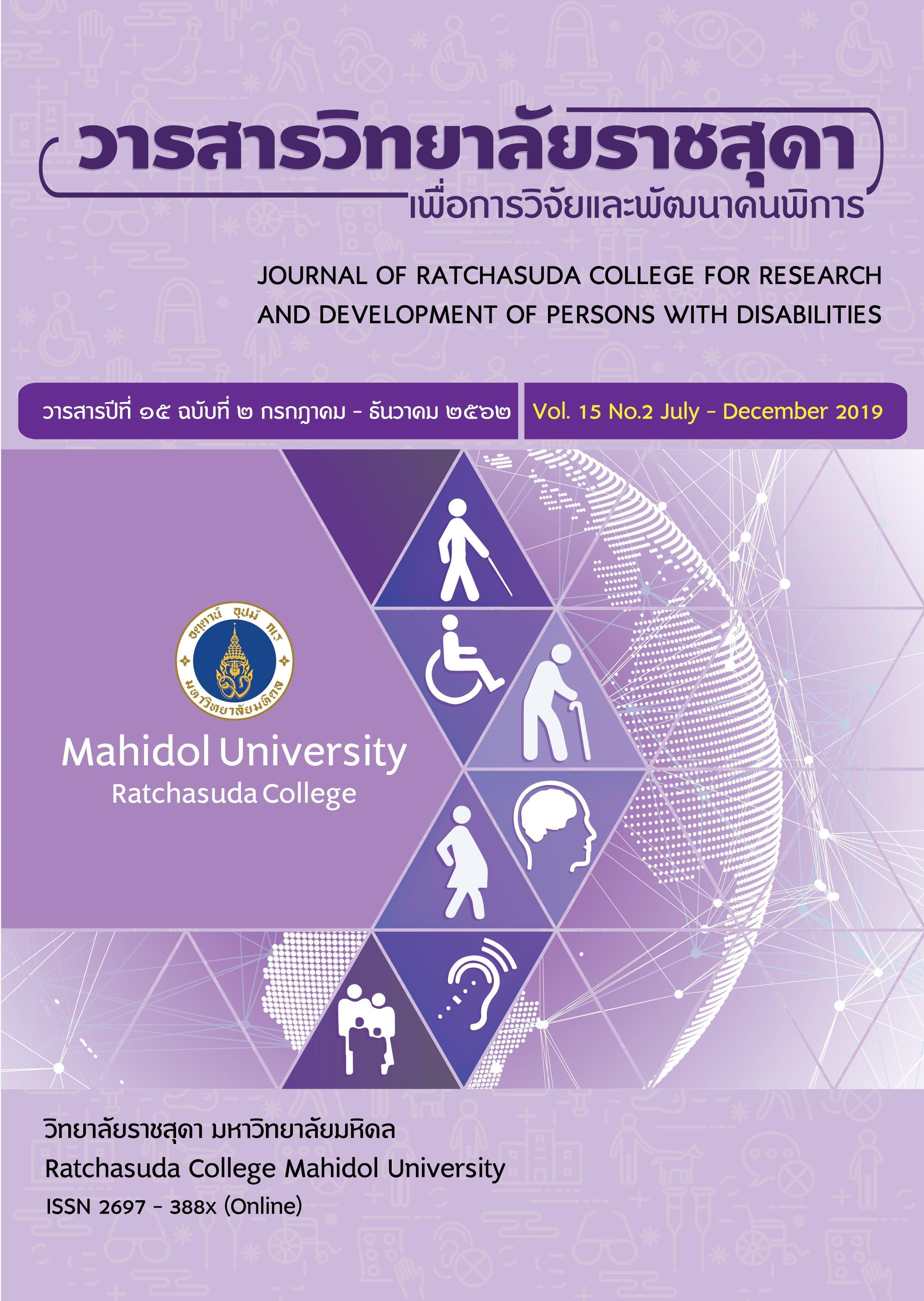Causes of irreversible blindness in the Mettapracharak (Watraikhing) Eye Center among the elderly between 2010 and 2016
คำสำคัญ:
ตาบอด, เมตตาประชารักษ์ (วัดไร่ขิง), ผู้สูงอายุบทคัดย่อ
This cross sectional study aims to evaluate the causes of irreversible blindness among This cross sectional study aims to evaluate the causes of irreversible blindness among the elderly in the Mettapracharak (Watraikhing) hospital between 2010 and 2016. The sample of the study were new eye outpatients attending the hospital between 2010 and 2016. The participants aged more than 60 years old with irreversible legal blindness in accordance with the World Health Organization criteria (best corrected visual acuity less than 3/60 or visual field less than 10 degree in the better eye despite all medical and surgical interventions. The statistics used were frequency, percentage, mean and standard deviation.
The results of the study showed 8483 patients to be recruited, 5183 (61.1%) were females and 3300 (38.9%) were males. 1281 (15.1%) had legal blindness. 230 (18.0 %) were
bilateral blindness. Main causes of visual loss were as follows: 220 (17.2%) glaucoma, 214 (16.7%) diabetic retinopathy, 183 (14.3%) age-related macular degeneration, 78 (6.1%) ocular vascular occlusion, 54 (4.2%) retinitis pigmentosa, 35 (2.7%) optic atrophy, 15 (1.2%) amblyopia, 150 (11.7%) combination of causes, 113 (8.8%) corneal disorder and others 219 (17.1%). The most commom cause of irreversible blindness among the elderly was glaucoma, diabetic retinopathy and age-related macular degeneration respectively.
Policy Recommendation is to know the cause of irreversible legal blindness that can Policy Recommendation is to know the cause of irreversible legal blindness that can initiate the government and eye care specialists in promoting more suitable strategies for the better awareness of these avoidable complications.
Downloads
เอกสารอ้างอิง
Chen, D., Otero-Millan, J., Kumar, P., Shaikh. AG., & Ghasia FF. (2013). Visual Search in Amblyopia: Abnormal Fixational Eye Movements and Suboptimal Sampling Strategies. Invest Ophthalmol
Vis Sci, 59(11), 4506-4517.
Cunningham, ET Jr. (2001). World blindness — no end in sight. Br J Ophthalmol, 85, 253-4.
Ferris, FL III., & Tielsch, JM. (2004). Blindness and visual impairment: a public health issue for the future as well as today. Arch Ophthalmol, 122, 451-452.
El-Gasim, M., Munoz, B., est, SK., & Scott, AW. (2013). Associations Between Self-Rated Vision Score, Vision Tests, and Self-Reported Visual Function in the Salisbury Eye Evaluation Study.
Invest Ophthalmol Vis Sci., 54(9), 6439-6445.
Foster, PJ., Wong, JS., Wong, E., Chen, FG., Machin, D., & Chew, PT. (2000). Accuracy of clinical estimates of intraocular pressure in Chinese eyes. Ophthalmology ; 107: 1816-21
Fredrick, DR. (2017). Swaiman’s Pediatric Neurology (6th ed) Edition). San Francisco co: Elsevier Inc.
Furashova ,O., & Matthé E. (2017). Retinal Changes in Different Grades of Retinal Artery Occlusion: An Optical Coherence Tomography Study. IOVS, 58, 5209-5216.
Ho, VH., & Schwab, IR. (2001). Social economic development in the prevention of global Blindness. Br J Ophthalmol, 85, 653-7.
Homer, JB., & Hirsch, GB. (2006). System dynamics modeling for public health: background and opportunities. Am J Public Health, 96(3), 452-8.
Horowitz, A. (1994). Vision impairment and functional disability among nursing home residents. Gerontologist, 34, 316-323.
Horowitz, A., Reinhardt, J., McInerney, R., & Balistreri, E. (1994). Age-related vision loss: Factors associated with adaptation to chronic impairment over time. New York: The Lighthous
Idil, SA., Altinbay, D. (2019). Current Approaches to Low Vision (Re) Habilitation. Turk J Ophthalmol, 49(3), 154-163.
Khaw KT. (1997). Epidemiological aspects of ageing. Philes Trans R Soc Lond B BiolSci, 352(1363), 1829-35.
Knodel, J., Prachuabmoh, V., & Chayovan, N. (2013). The Changing Well-being of Thai Elderly An update from the 2011 Survey of Older Persons in Thailand. (1st ed). Bangkok: HelpAge International East Asia/Pacific Regional Office.
Michon, JJ., Lau, J., Chan, WS., & Ellwein, LB. (2002). Prevalence of visual impairment, blindness, and cataract surgery in the Hong Kong elderly. Br J Ophthalmol, 86, 133-9.
O’Connor, PM., Harper, C., Brunton, CL., Clews ,SJ., Haymes, SA., & Keeffe, JE. (2012). Shared care for chronic eye diseases: perspectives of ophthalmologists, optometrists and patients. Med J Aust, 196(10), 646.
Osaguona, VB. (2016). Differential diagnoses of the pale/white/atrophic disc. Community Eye Health ; 29 (96), 71-74.
Tsai, IL., Woung, LC., & Tsai, CY. (2008). Trends in blind and low vision registrations in Taipei City. Eur J Ophthalmol., 18, 118-24.
Wilkinson, CP., Ferris, FL 3rd., Klein, RE., Lee, PP., Agardh, CD., Davis, M., Dills, D., Kampik, A., Pararajasegaram, R., & Verdaguer, JT. (2003). Global Diabetic Retinopathy Project Group. Proposed international clinical diabetic retinopathy and diabetic macular edema disease severity scales. Ophthalmology, 110(9), 1677-82.
Wong, TY., Loon, SC., & Saw, SM. (2006). The epidemiology of age related eye diseases in Asia. Br J Ophthalmol, 90, 506-11.
World Health Organization. (1988). Coding instructions for the WHO/PBL eye examination record version III). Geneva: World health Organization, PBL/88.1.
World Health Organization. (1992). The ICD-10 Classificati on of Low Vision and Blindness. Clinical Descriptions and Diagnostic Guidelines. Geneva: World health Organization.
World Health Organization. (2017). Vision impairment and blindness. Factsheet. Retrieved from http://www.who.int/pbd/blindness/WorldSightDay17Infographic.pdf.
World Health Organization. (2018). Blindness and vision impairment. Retrieved from http://www.who.int/news-room/factsheets/detail/blindness-and-visual-impairment.
ดาวน์โหลด
เผยแพร่แล้ว
รูปแบบการอ้างอิง
ฉบับ
ประเภทบทความ
สัญญาอนุญาต
บทความที่ได้รับการตีพิมพ์เป็นลิขสิทธิ์ของวารสารสถาบันราชสุดาเพื่อการวิจัยและพัฒนาคนพิการ






